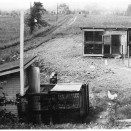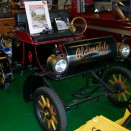Cuyahoga Falls was plagued with as many problems 176 years ago as they do today. The only difference between now and then was that the Falls was a township and lawmakers were called trustees and the issues were of a different nature. The included issues such as swine running loose in town, ball playing on Front Street, theft of the town cannon, and people ‘snitching’ fire ladders in 1837.
The very first volume of the Cuyahoga Falls Records is a faded and battered leather bound book that tells much of our early history and growing pains of Cuyahoga Falls.
The very first entry in this book, written in longhand with goose quill pen, is dated March 5, 1836. It was an act, passed by the General Assembly, “To incorporate the Town of Cuyahoga Falls in the County of Portage.”
The following month smallpox broke out in the Falls and “Drs. Rice and Peckham were hired to vaccinate citizens of this town at the public expense.” At the same time the marshal was ordered to put a sign on McCannon’s store, just north of Broad and Front Streets indicating the existence of smallpox in the area.
Fire Company No. 1 was organized on February 3, 1837, and an ordinance passed making it necessary for every store owner, home owner and others to hang a fire bucket of good leather quality in their home or building.
On June 3, 1837, Mr. Sill presented the council with a petition from many local residents asking to restrain swine from running at large in town. So the city council ordered that all hogs to be locked in the town pound until “liberated by the owner at 20c a head.” However, on July 17, public pressure forced council to suspend the anti-swine ordinance and the pound keeper was instructed to “cease molesting citizens’ swine.” (It’s a good thing we don’t use the same terminology these days.) Apparently it wasn’t just a pig problem because on May 11, 1840 an ordinance was passed allowing citizens to be fined $5 if they allowed their dogs to run around town.
On August 9, 1837, the marshal was instructed to take charge of the town cannon and keep it in good order. Someone, however, must have misplaced the cannon, because on July 2, 1838, council issued the following: “It is the opinion of the Town Council that the cannon has legally been placed in custody of the marshal. Any person having it in their possession should return it to him immediately.” The cannon never showed up and the next month, according to the record, Mr. Wetmore brought up the subject of the cannon. Dr. Rice made a motion to drop the subject. I wonder whatever happened to this cannon?
 Genuine Cuyahoga Falls Police Whistle
Genuine Cuyahoga Falls Police Whistle
On June 15, 1837, council authorized the marshal to arrest people playing ball in “Broad Street, between Second Street and ‘the canal” as well as in “Front Street between Broad and Second Streets.” They were to be fined no less than 25c and no more than $1.
The Church Park was set aside on December 5, 1839 with instructions given that it was to benefit the public as a ‘Common’ and for sites of worship, state buildings and county offices.
Bridges also gave the early trustees lots of trouble. In November of 1840 the Portage Street bridge was reported unsafe for teams (of horses – for you youngsters out there) to cross and the Marshal was instructed to close it. The following month, trustees authorized $330 to William Beal and Henry Scott to build and furnish material for a brand new bridge. Apparently the trustees weren’t going to trust the builders to know what they were doing because the contract specifically said the bridge “was to be built from bank to bank of the river.” After the bridge was completed, trustees passed a law making it an offense to smoke while crossing the new covered bridge. This was probably our very first no smoking law!
An ordinance passed on June 14, 1841 forbid any person to go into the Cuyahoga River or the Canal…naked. No more skinny dipping for Cuyahoga Falls residents. At least, lawfully.
It really seems the Marshal was quite a busy man in the Falls. He was a man of many hats. Besides gathering up loose dogs and swine and posting notices he also had to keep all the crosswalks clean, survey the public and private lands, preside over the town jail (what they referred to as a lock-up), and “protect ladies and freeholders from vulgar and obscene remarks of three or more persons gathered on the town sidewalks.”
If the Marshal failed to do these things? An ordinance passed on April 21, 1838 stated that if the Marshall refused or neglected to carry out the town laws he would be fined between $5 and $10.
There was one other man that seemed to work as tirelessly as the Marshal. Mr. Dewey was hired on June 5, 1838, to take charge of the burying ground and protect all the trees and fences, dig all the graves, and keep all the records. He was paid $1 for each person buried. In case that wasn’t enough tasks for the poor man, they also paid him $40 a month to ring the town bell which must have been quite a job within itself if they were paying that much!
These records remind me of some incidents that I read on Cuyahoga Falls Patch or our Falls Reporter. We still have trouble down with children on Front Street that has caused the city to ban anyone under 18 after 8pm. We still have people playing in the river when they’re not supposed to. We also have some really busy city workers that fall into bed each night….and others that don’t. Can you think of things in Cuyahoga Falls that are similar to the 1830’s?


